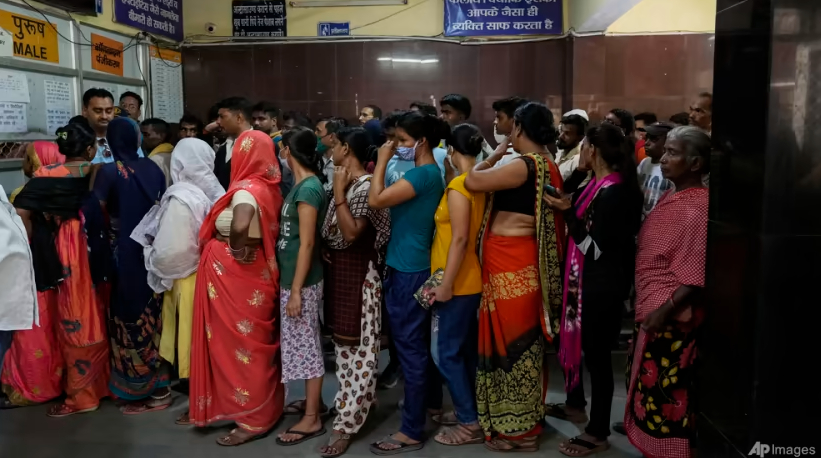November 27, 2025 | 18:54 GMT +7
November 27, 2025 | 18:54 GMT +7
Hotline: 0913.378.918
November 27, 2025 | 18:54 GMT +7
Hotline: 0913.378.918

People crowd the registration counter at Tej Bahadur Sapru Hospital in Prayagraj, Uttar Pradesh state, India on Jun 23, 2022. Photo: AP/Rajesh Kumar Singh
At least 34 people have died in the past two days as a large swath of the north Indian state Uttar Pradesh swelters under severe heat, officials said on Saturday (Jun 17), prompting doctors to advise citizens over 60 to stay indoors during the daytime.
The dead were all over 60 and had pre-existing health conditions that may have been exacerbated by the intense heat. The fatalities occurred in Ballia district, about 200km southeast of Lucknow, the state capital of Uttar Pradesh.
Twenty-three deaths were reported on Thursday and another 11 died on Friday, Ballia’s Chief Medical Officer Jayant Kumar said.
“All the individuals were suffering from some ailments and their conditions worsened due to the extreme heat,” Kumar told The Associated Press on Saturday. He said most of the deaths were because of heart attack, brain stroke and diarrhoea.
Diwakar Singh, another medical officer, said these people were admitted to Ballia’s main hospital in critical condition. “Elderly people are vulnerable to extreme heat too,” he said.
India Meteorological Department data shows Ballia reported a maximum temperature of 42.2 degrees Celsius on Friday, which is 4.7 degrees Celsius above normal.
The scorching summer has sparked power outages across the state, leaving people with no running water, fans, or air conditioners. Many have staged protests.
Uttar Pradesh Chief Minister Yogi Adityanath assured the public that the government was taking all necessary measures to ensure an uninterrupted power supply in the state. He urged citizens to cooperate with the government and use electricity judiciously.
“Every village and every city should receive adequate power supply during this scorching heat. If any faults occur, they should be promptly addressed,” he said on Friday night in a statement.
The main summer months — April, May and June — are generally hot in most parts of India before monsoon rains bring cooler temperatures. But temperatures have become more intense in the past decade. During heat waves, the country usually also suffers severe water shortages, with tens of millions of its 1.4 billion people lacking running water.
A study by World Weather Attribution, an academic group that examines the source of extreme heat, found that a searing heat wave in April that struck parts of South Asia was made at least 30 times more likely by climate change.
In April, the heat caused 13 people to die at a government event in India’s financial capital of Mumbai and prompted some states to close all schools for a week.
(AP)

(VAN) A new study reveals how the simultaneous effects of ocean acidification, salinity and loss of oxygen are making the world more fragile.

(VAN) Hopes are growing that the creation of the first 3D turkey gut model could be a turning point in the battle against the virulent blackhead disease.

(VAN) Tyson, America’s biggest meat supplier, plans to shutter one of its largest beef processing plants as the industry continues to struggle with low cattle supplies and political pressure from Washington.

(VAN) New FAO study shows how digital solutions are empowering farmers and fishers to prevent losses and build resilient agrifood systems.

(VAN) Brazil's COP30 presidency pushed through a compromise climate deal on Saturday that would boost finance for poor nations coping with global warming but that omitted any mention of the fossil fuels driving it.

(VAN) Poultry farmers in the UK have been warned that they could face one of the worst winters yet for bird flu.

(VAN) Prices of main-crop paddy have risen sharply, with jasmine rice hitting 16,100 baht per tonne — the highest level in years.